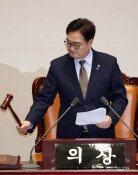The Great Goryeo exhibit celebrating 1,100 years of foundation
The Great Goryeo exhibit celebrating 1,100 years of foundation
Posted January. 11, 2018 08:09,
Updated January. 11, 2018 08:29
The uniqueness and beauty of the inlaid celadon of Goryeo is world-renowned. The sanggam inlay technique was taken from the lacquerware decoration method that engraves patterns on the surface and inserts earth in the same shape. After the pattern is formed, it is taken into a kiln of high temperature and baked, which is also a highly advanced technique. The sanggam method reached its zenith in the early 12th century and turquoise sanggam-made celadons were even exported to the Song Dynasty, where celadon making techniques originated from. A number of relics are designated as national treasures. The mysterious blue celadons, Buddhist drawings, lacquerware and movable type printing press represent the top four works of the Goryeo Dynasty.
Goryeo was known for its creativity, creating astounding inventions. This was partly due to its openness, absorbing Islamic and Chinese culture and reflecting these influences in its culture. Such richness was evident in astronomy, calculation, medicine, measurement, printing and gunpowder making technology. After the military regime came to power, Goryeo began to decline. King Sejong’s golden age of scientific advancement in the early Joseon Dynasty was made possible due to Goryeo’s advanced scaling technology. Gunpowder, which was invented by military commander Choi Mu-Seon, even reversed the flow of history. It helped King Taejo defeat the Japanese, which made him a war hero and build a new dynasty.
In celebration of 1,100 years of the foundation of Goryeo Dynasty, the National Museum of Korea has opened an exhibition titled “The Great Goryeo.” The special exhibition will showcase Goryeo’s top four works as well as other Goryeo cultural relics scattered around the world. It will reveal the essence of the open and unique science technologies of Goryeo. “The movable print, Tripitaka Koreana (printing woodblocks of Buddhists texts) and celadon represent Goryeo’s creativity. Goryeo became not only the foundation of Korea’s present name but also our national identity,” said Bae Ki-dong, director general of the museum.
The National Museum of Korea worked with UNESCO and the International Council of Museums to bring Goryeo relics from North Korea. It also sought support from the Ministry of Unification, taking advantage of relieved tensions on the peninsula and seeking direct talks with the North. It would be interesting to open a travelling exhibition in both Seoul and Pyongyang if inter-Korea relations stay amicable after the PyeongChang Winter Olympics. We hope that the special exhibition will open new horizons for inter-Korean exchange. This, of course, would only be feasible when the two Koreas remain on good terms.
tao4@donga.com







